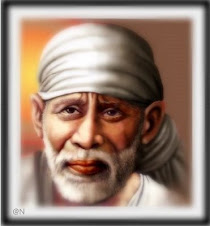
Baba would spend much of his time in the mosque sitting in front of the dhuni, often with his arm leaning on a little wooden balustrade. A large portrait of Baba, sitting in the same posture, is now to be found here. The picture is kept on a throne-like platform and is the focus of worship, just as Baba himself was when he sat here. Baba sits relaxed and calm, looking out at us with a warm, welcoming, almost amused expression; at the same time the gaze is both penetrating and searching. On seeing the finished work, Baba is reported to have said, "This picture will live after me."
Of the few pictures there are of Baba, we feel we could be looking at a different person in each of them. In satsang Sri Babuji once described the phenomenon of the ever-changing features of a saint's face which he likened to a river: when we watch a flowing river, in one way it is the same river, and in another way it is always different, the water always moving. The saint is one whose actions are free from the influences of past or future. In this way, he is constantly being reborn, each moment a fresh moment, each moment a fresh life! That is why we never get tired of looking at a saint's face - there is always something new in it.
Something of that freshness is evident when we look at the portrait here. No matter how many times we take its darshan, we feel that Baba is greeting us anew. For that, we are indebted to the artist, S. R. Jaikar, from Bombay. The original picture was painted under commission from a close devotee (M. W. Pradhan). At first, Baba did not give permission for the work, claiming that he was just a simple beggar and fakir and what was the point of painting such a person. It would be better for Shama (who relayed the request to Baba) to get his own portrait done, suggested Baba! Luckily for future gen-erations, though, Baba later relented and Jaikar actually painted four pictures, one of which was touched by Baba.
The picture was installed in Dwarkamai after Baba's maha- samadhi. The painting that we see now is a recent copy of Jaikar's original, which was moved to a Sansthan office to preserve it from the drying effects of the dhuni. It can currently be viewed in the Museum Hall adjacent to Dixit Wada.
In front of the portrait is a pair of silver padukas which was installed later. Here it may be worth adding a note about the significance of padukas. They are used throughout India, but particularly in the Datta cult in Maharashtra. Padukas may be a pair of carved "footprints" or a pair of shoes used by the saint. It is the former which we mostly see in Shirdi. Padukas signify the presence of the saint - wherever the feet are, the rest of the body will be! - and thus they are revered.
In Dwarkamai alone, there are five sets of padukas, symbolizing Baba's presence and aiding us in remembrance and worship. Taking the lowest part of the saint's body, we touch it with the highest part of our own (the head) as a gesture of obeisance and respect, in an act of namaskar. When we bow down we are adoring our Beloved, affirming our hallowed connection, and in this way, asking for continued blessings. Sri Babuji elucidates the meaning of namaskar as follows: "The term is said to be a compound of three root words: na (=no) + mama (=I) + aaskaara (=scope) =no scope for the 'I'. Thus it is a state of mind in which the self is effaced by an expressive recognition of the divine magnitude. To bear such a self-effacing feeling in mind is true namaskar ...namaskar symbolizes the state of the ego's readiness to lose itself... [and] is not a mere deferential gesture of greeting, [but] a meaningful technique handed down by the masters of mystic wisdom as a means of effacing the ego."








No comments:
Post a Comment